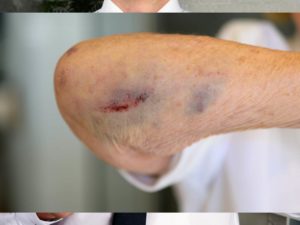What Is Soft Tissue?
Soft tissue is a general term used to describe the types of cells that work together to connect, support, envelope, and/or move surrounding structures such as bones. These tissues can have a varying degree of relation to the spine. Fat, skin, nerves, and blood vessels are all critical kinds of soft tissue, but others are more likely to be injured and require chiropractic care. The four major types of soft tissue treated by a chiropractor are muscles, tendons, ligaments, and fascia.
Muscles
Muscles surround joints in the body, protecting them and allowing them to create motion. By contracting and relaxing in response to the nervous system, muscles are the main engine behind all movement in the body. It is important that these muscles have enough strength to support the joints, especially the spine, so that they can easily move in all intended directions.
A muscle can be torn, strained, sprained, and otherwise damaged, causing pain or an inability to move that area of the body.
Fascia
Small bundles of muscle fiber and larger groups of muscles are often surrounded by a soft tissue called fascia. This helps to support the integrity and movement of these muscles, ideally gliding smoothly. When there is an injury to the fascia or a chronic issue, it can thicken, leading to pain and stiffness. This is often mistaken for muscle tension but requires different treatment.
Ligaments and Tendons
The bones of a joint are held together by ligaments, strong bands of connective tissue. Because ligaments cross the joints, they help to prevent excessive movement that can potentially be harmful.
A similar connective tissue forms tendons, which attach the muscle to the bone. During contraction, a muscle will tug on the tendon, which moves the bone.
Soft Tissue Injuries and the Spine
The spine is made up of a series of joints, including the ligaments and tendons associated with a joint. It is also surrounded by muscles and fascia. An injury to this tissue can have a negative effect on the spine, and an injury to the spine can impact the tissues. Mild soft tissue injuries are common, with a grading scale used to determine severity.
An injury to a muscle or tendon is known as a strain, while an injury to a ligament is a sprain. While these are often confused, they do differ. In both cases, the grading scale looks like this:
- Grade 1 is mild. Fibers may be slightly damaged.
- Grade 2 is moderate. There will be partial tearing of fibers. If this is near a joint, movement may be loose during certain motions.
- Grade 3 is severe and represents a total tear or rupture. These injuries are serious and require immediate medical attention.
Even when there is not an acute injury, the overall condition of soft tissues can have an impact on your health and pain levels. When the tissue is overworked or overstretched, too tight, or out of shape, this can cause discomfort and other symptoms. Prolonged issues like this may lead to chronic pain or create issues where the spine cannot be properly supported.
 Common Soft Tissue Injuries and Conditions
Common Soft Tissue Injuries and Conditions
Injuries to the soft tissue can occur as a result of a one-time trauma, like a fall or car accident, or due to overuse and misuse of the tissue over time. Each type of injury may vary in severity and treatment plans.
These are some of the injuries most commonly seen by chiropractors who treat soft tissue injuries.
Sprains
When a ligament is stretched or torn, they are no longer able to stabilize the joints they are connected to, causing pain and trouble with control of the joint. Ankles, wrists, and knees are commonly sprained, especially during a fall or other incident that places extreme tension on the ligaments.
Pain, bruising, swelling, and inflammation are the most common symptoms of a sprain. The majority of these injuries can be treated with rest and basic pain relief, though more severe cases may require bracing or even surgery.
Strains
Muscles or tendons that are stretched or torn are known as strains. This can happen anywhere in the body, though the back of the leg or hamstring is a common location. Athletes who participate in contact sports are at higher risk of a strain, as well as sports that require a lot of quick starts or intense gripping.
Symptoms of a strain may include pain, muscle spasms, muscle weakness, cramping, swelling, and inflammation. Similar to a sprain, rest and pain management are usually enough to address a strain unless there is a complete tear or in other severe cases.
Contusions
Also known as a bruise, a contusion can occur when a direct blow or repeated blows strike part of the body. This can crush underlying muscle fibers and connective tissue without breaking the skin. Falls, hitting a surface hard, or repetitive contact with a hard surface can all cause bruises. The discoloration comes from blood pooling around the injury internally.
Most bruises resolve without any intervention, but a contusion that persists should be treated to ensure no permanent damage was done.
Tendinitis
Tendons are covered in something known as a sheath- when this becomes irritated or inflamed, it is known as tendinitis. This is typically caused by a series of small stresses that aggravate the tendon, causing inflammation over time. Swelling and pain that worsens with the related activity are common signs of tendinitis.
Many professional athletes will suffer from tendinitis due to the repetitive motions associated with their sport. Professional baseball players, swimmers, golfers, and tennis players often experience the condition in their elbows and shoulders; soccer and basketball players, runners, and aerobic dancers are more likely to see symptoms in their knees and ankles.
Tendinitis can be addressed with rest, avoiding the motion that caused the injury, anti-inflammatory medication, steroids, splintering, and exercises to correct imbalances. If tendinitis is not addressed early, it can cause permanent damage to the tendon and may require more invasive options like surgery.
Bursitis
Throughout the body are small, jelly-like sacs that contain a small amount of fluid known as bursae. These are positioned between bones and soft tissue to act as a cushion and reduce friction- they are found in the shoulder, elbow, hip, knee, heel, and other areas of the body. When the bursae are stressed over time, they can swell, causing pain and swelling. Bursitis often occurs in conjunction with tendinitis, though not always.
The primary methods of treating bursitis are changes in activity and anti-inflammatory medication like ibuprofen. In cases where this does not relieve symptoms, fluid can be removed from the bursa, and steroid injections can be administered.
Stress Fracture
With enough pressure over time, a bone may become very slightly cracked in what is known as a stress fracture. This is most common in the legs and feet, as they bear the weight of the body during movement. In addition to overuse, a sudden spike in physical activity can also lead to stress fractures. A stress fracture will be very painful, worsening with pressure, and may also cause swelling.
Stress fractures are treated by removing as much weight as possible from the bone and possible casting or immobilization. The goal is to prevent the fracture from becoming a full break which could require surgery to repair.
Concussions
This mild traumatic brain injury is known to impact brain tissue, making them a form of soft tissue injury. Concussions are often caused by a blow to the head or during a sudden impact, when the brain moves within the head and causes blunt force trauma. Symptoms may include nausea, headaches, cognitive challenges, and sensitivity to light.
Concussions usually resolve with careful monitoring, but because they are brain injuries, careful attention should always be paid to symptoms.
Chiropractic Care for Soft Tissue Injuries
When it comes to soft tissue injuries, chiropractors may be able to help in a number of ways.
The primary method used by chiropractors is a manual adjustment, in which the spine is carefully manipulated to return to alignment. When the spine is aligned properly, the soft tissue surrounding it does not have to work harder for stability and stress can be relieved. This may also eliminate imbalances that cause strain on parts of the body. A spine that is well-aligned is also able to facilitate better nerve communication throughout the body, which can help relieve overall stress and inflammation that may irritate tissues.
These adjustments are often paired with physical therapy. This practice helps to restore any lost flexibility and strength to the body’s tissues, as well as helping them to improve to prevent further injury. Often, these exercises can be used at home and well after recovery to ensure tissues remain strong and are able to sustain stress more effectively in the long run.
In addition to treating injuries, chiropractors and physical therapists often work together to craft prevention plans. For athletes and those who may be at higher risk of overuse injuries, it can be critical to avoid issues altogether through active management of physical activity. Focusing on activity, diet, posture, and other environmental factors can help prevent future injury and keep the body strong enough to perform athletic feats.
Chiropractors may also use other techniques, such as:
- Therapeutic massage to loosen up stiff and tense muscles or joints.
- Ultrasound therapy. This creates heat to loosen up muscles, decreases swelling, increases blood flow, and improves range of motion.
- Electrical muscle stimulation (EMS) to relieve pain and reduce muscle spasms.
- Heat therapy to address strains and stiff muscles.
When a soft tissue injury does not approve with this combination of treatments, or if it is a very severe injury, a chiropractor may recommend you work with other professionals for treatment.

College Park Chiropractors for Soft Tissue Injuries
At AICA College Park, our chiropractors are eager to help address any soft tissue pain or injury you may be suffering from. Through a combination of manual adjustments and other techniques, our goal is to create a customized treatment plan that will help you to reach your goals and relieve pain. We see everyone from professional athletes to car accident victims in our office.
Our staff includes physical therapists and pain management specialists who work hand in hand with our chiropractors to ensure that your plan of care is thorough, comprehensive, and aimed at finding the root cause of your concern. With this information, we can create a comprehensive treatment protocol that not only addresses your immediate concerns, but also helps you build a foundation moving forward that leave you stronger and less prone to injury.
If you need further care, AICA College Park is also home to a team of orthopedists and neurologists who can work alongside your chiropractor to develop more intensive therapies aimed at your needs. Rather than a referral to a new practice where you need to start from square one, we offer an integrated team of experts who work together every step of the way and ensure a seamless process for you. We even have diagnostic imaging tools available onsite so you do not need to add another office to your rotation.
Whether you have suffered a soft tissue injury or are hoping to prevent problems in the future, the chiropractors at AICA College Park are here to help. Contact us today to schedule your first consultation!